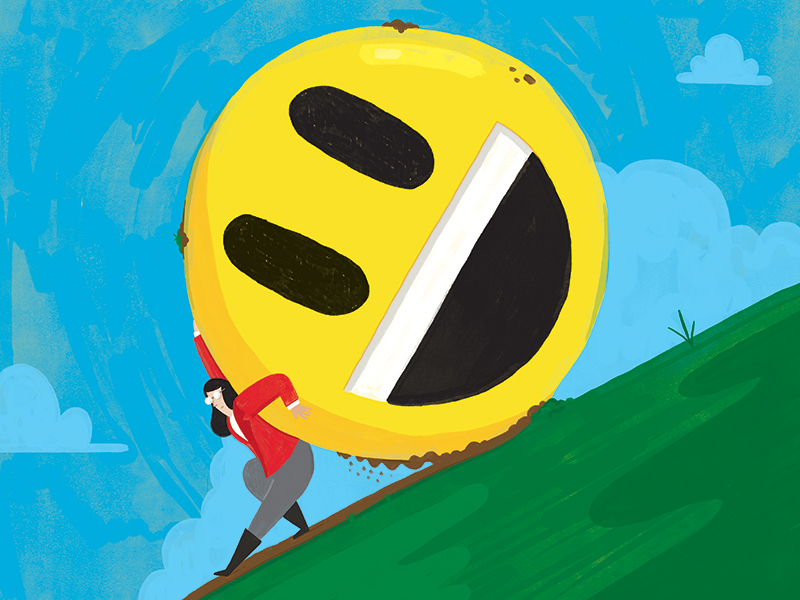Managers know that happy employees are more productive and provide better customer service, but what is the cost of that service with a smile?
New research from the Terry College of Business reveals becoming a happy, helpful employee takes effort and, eventually, that effort erodes the energy needed to do one’s job.
Fadel Matta, an associate professor of management; Jessica Rodell, William Harry Wilson Distinguished Chair in management; and Emma Frank, an assistant professor of management at the University of New Hampshire and a recent Terry Ph.D. graduate, published their findings in the July edition of the Journal of Applied Psychology.
In “What Does It Cost You to Get There? The Effects of Emotional Journeys on Daily Outcomes,” Matta, Rodell and Frank focus on employee transitions from bad moods to good moods during the day. That transition — or “emotional journey” aspect — is often missing in organizational psychology research that focuses on keeping employees happy and productive, Matta said.
“Our entire literature is built on this idea that we want people to have positive emotions all the time,” Matta said. “That’s the overarching goal that’s put out there, but it ignores the state any one employee is in at any given time. Some employees start the day in a positive place, others come into work in a bad mood.
“We’re not saying we don’t want people at work to be happy and content. We do, but it’s not that simple.”
The more people adjust their moods to be happy, the fewer emotional resources they have at the end of the day. That means they are less able to handle challenging tasks and interactions and have a harder time staying on task. Their tank is empty despite being in a good mood, Frank explained.
“At work, that means you’re more likely to be short with coworkers or peruse the internet rather than do your work,” Frank said. “Even if you’re feeling good and ending your day on a high note, you’re not going to be ready to perform your best.”
Frank, Rodell and Matta surveyed 162 working professionals in different fields, asking them to rate their mood five times a day for 10 days. At the end of each day, they measured the employee’s performance by asking whether they volunteered to help with a project, snapped at a coworker or had difficulty staying on task.
The team compared each employee’s response to their previous responses to measure their individual changes in mood and performance versus their own individual baseline moods and not to the moods of other employees. This was in effort to show that their findings were valid for the happiest employees and the chronically grumpy.
Workers with the biggest daily mood shifts were more likely to feel depleted at day’s end and more likely to report bad work behaviors.
Frank, Rodell and Matta also replicated these results in a laboratory setting in which participant emotions (and emotional trajectories) were experimentally manipulated and depletion/behavior were tracked in a controlled environment.
Until now, organizational psychologists spent a lot of time researching how employees’ moods affect their productivity and willingness to collaborate. But not much attention was paid to what Matta, Rodell and Frank call “the emotional journey.”
The emotional journey can be an employee’s mood involuntarily changing as good things happen to them or the conscious process an employee goes through to force themself into a better mood.
“(The emotional journey we looked at) was the process of altering an emotional state, so it could be things that happen to you or a change you make on purpose,” Matta said. “Like you’re in a bad mood, and then something great happens to you at work and that changes your emotional state. Or it can be a conscious process where you tell yourself that you need to get in a good mood.”
The studies found both scenarios depleted workers’ emotional resources.
“I think that a lot of times we might assume that ending the day on a high note would be a good thing, but what we found is that starting from that low point and getting to that high point depletes the resources you have left in the day,” Frank said.
Over time, exhausting these emotional resources over and over can lead to burnout, she added.
For managers, this means it may make more sense to meet employees where they are emotionally and not force upbeat attitudes in the office. For employees, it may mean letting bad days happen and leaving more mood-demanding work — such as sales calls or tough conversations — for better days.
“We want people to be in a good place, but we want them to come to work in a good place,” Matta said. “If something bad just happened to you at work, I think the work that’s required to get you to a better place may not be worth it.”

